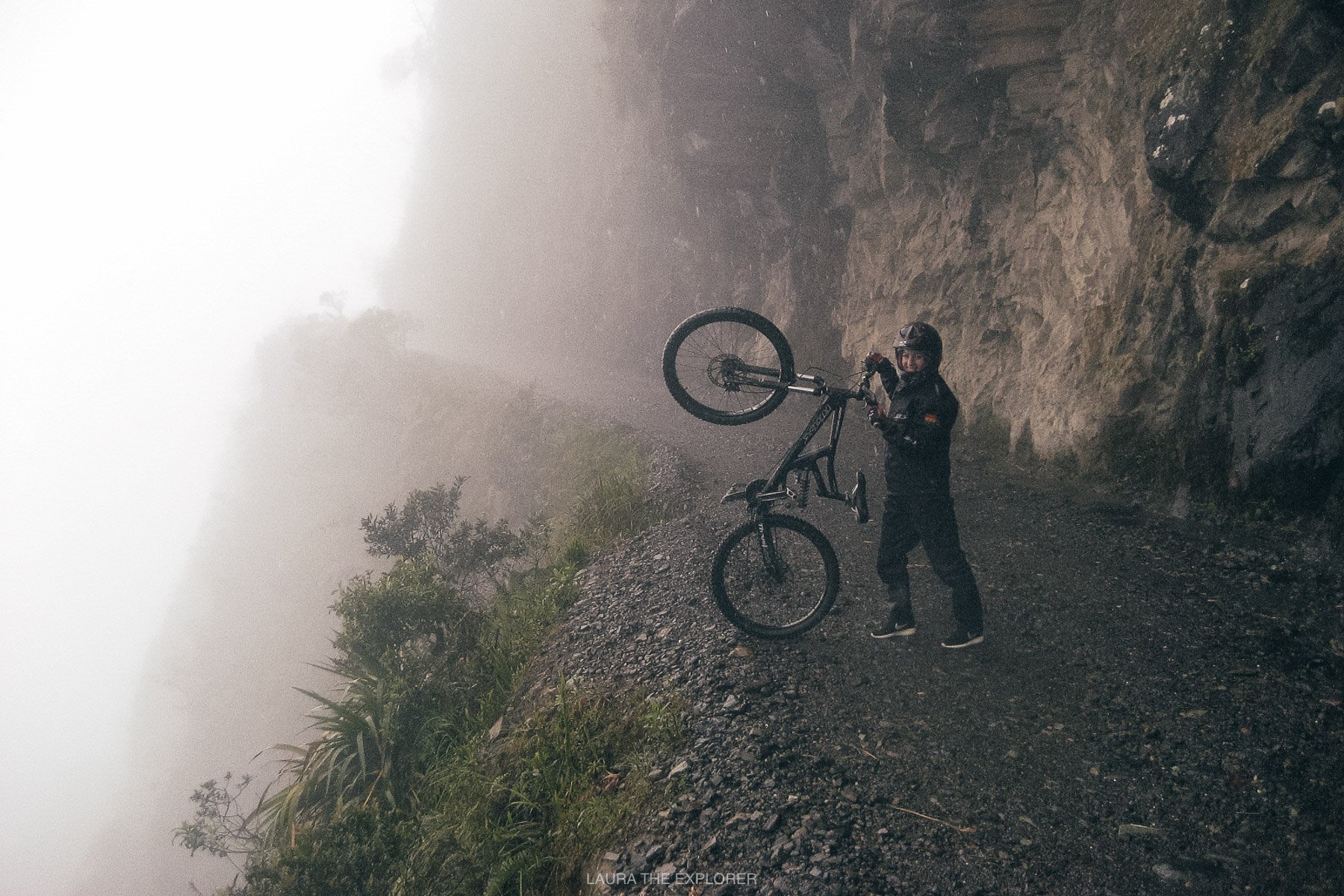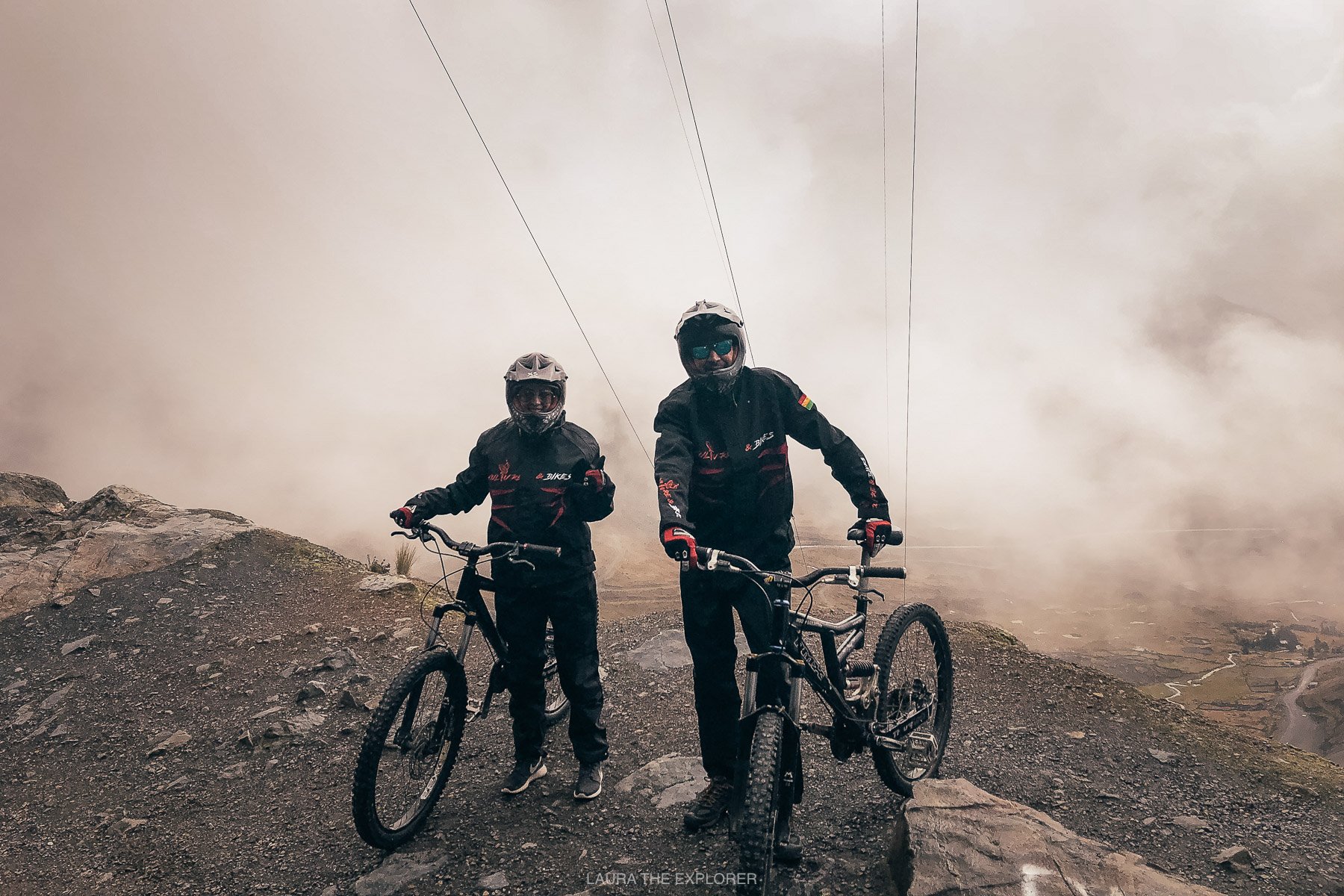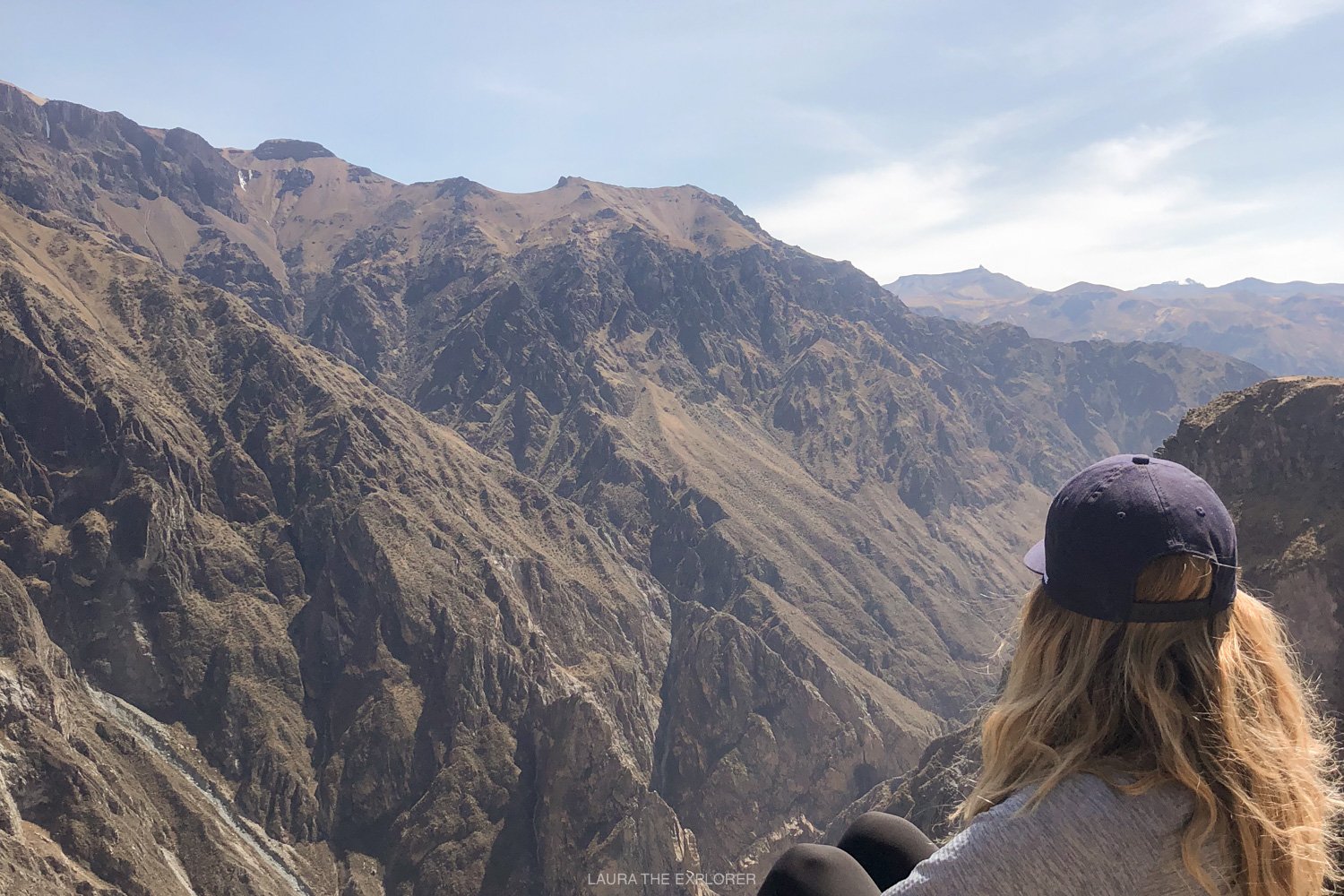Why You Should Bike The Death Road in Bolivia
Looking for one of life’s bucket-list adventures?
Or maybe you’re looking to get outside of your comfort zone, throw caution to the wind and take on a once-in-a-lifetime experience that would never happen back home?
Something that you’ll tell your parents about after you’ve done it, but is definitely going to be one of those exhilarating moments that really make you feel alive?
Then why not Bike the Death Road in Bolivia.
One of the best things to do on a trip to La Paz, from the incredible views, the rush of wind in your hair, and a chance to explore a different side of Bolivia, here’s everything you need to know before biking the death road.
SO WAIT, WHAT IS THE DEATH ROAD?
The Death Road, or the Camino de la Muerte, is an old road just outside of La Paz that’s cut into the side of the Andes mountains and runs from La Cumbre at an altitude 46000m of near the top, to the town of Coroico at an altitude of 1200m down in the Yungas Valley.
The road is famous due to the significant number of fatal accidents that occurred on the cliff-hugging route before a newer, safer alternative route was opened in 2006.
Opened in the 1930s after it’s construction by Paraguayan prisoners, around 300 people were killed while attempting the route which led to the road being named by Inter-American Development Bank as The Most Dangerous Road in the World.
The dangers came from the lack of barriers next to drops of 100s of metres, its relatively narrow width of 3-4m, sharps twists and turns, misty fog, waterfalls, and the occasional mudslide blocking the route. Its also one of few left-hand drive roads in the usually right-hand drive country - just so the driver could judge the edge of their vehicle’s wheels from the edge of the cliff!
Nowadays, the road is predominately trafficked by cyclists who want to experience the notorious adventure, along with a few locals who still use the route to access some remote villages.
Dangers do still exist, however, with some cycling tourists also adding to the road’s tally over the years. But with a cautious sense of adventure, good gear and a trusty guide, the opportunity to bike the Death Road is one of the best things to do when in La Paz, Bolivia.
WHAT TO EXPECT ON THE DEATH ROAD
FROM LA PAZ TO LA CUMBRE
Your tour guide will pick you up from your accommodation in La Paz and make the hour or so journey over the Andes to the start of the ride, also known as La Cumbre. Before jumping on the bikes, you’ll be served a hot breakfast and some coco tea and get the chance to ask your guide any questions. The guides will also give you a quick lesson on everything you need to know about the bikes and the first section of the ride.
The first section of the ride is a sealed road.
PART ONE OF THE DEATH ROAD RIDE
The first part of the ride is on a regular sealed road that is frequented by other traffic, and winds down the mountain at a gradual descent. This section is about 20km in length and all downhill. If you’ve ever ridden a bike on a trafficked road, this section will be totally manageable, the road is wide and smooth and all you need to do is to stick to the right hand side. The hardest part is keeping your hands warm as you wind your way down the mountain (bring gloves)!
Near the end of the sealed road is a small off-road detour that’s a little example of what the rest of the Death Road will be like. The tour guides will lead you through it and make sure you’re comfortable continuing on. Again, if you’re ever ridden a gravel road or dirt track, this section is totally manageable.
After the sealed section, you’ll actually jump back into the van for a little bit. This is to avoid the uphill section of the road, so as to keep things easy and enjoyable, and from here the van will drop you at the start of the next half of the ride.
PART TWO OF THE DEATH ROAD RIDE
The second part of the ride is on a gravel road, and it’s this part that’s the actual Death Road -North Yungas Road. This is what you came here for!
If you’ve ever ridden a bike on a gravel road or along a dirt path, you’ll also be totally fine biking this section. Starting from the famous start sign in Chuspipata, the road is wide enough to fit a bus and also runs downhill at a gentle gradient. The road is gravel, and therefore can be a bit muddy or rocky.
It’s here that the good suspension comes into play to help you navigate the road as smoothly as possible. Instead of sitting on the brakes the whole time, get comfortable letting yourself roll with the gentle descent and you’ll find the little but speed makes the whole ride smoother.
Throughout the ride, there should be one guide at the front of the pack and one guide at the back. You’ll never feel pressured to go faster than you feel comfortable going, nor will you ever be left behind.
On the other hand, experienced downhill riders are catered to as well. Near the bottom of the road there are some alternative (more adventurous) trails that you can opt in to taking, so if you have the abilities, there’s an opportunity to let loose here.
By the end you’ll be a pro
FINISH UP AT YOLOSA
After reaching the end of North Yungas Road, in the small village of Yolosa, it’s time to celebrate successfully biking the Death Road! You’ll head to a local resort style posada (the location depends on the tour company) for a meal and a shower, and there may even be a pool to relax and unwind in.
After the late lunch, the van will collect the group and make the two hour journey to drop you back at your accommodation in La Paz - but don’t worry - the van doesn’t actually drive back up the Death Road! The trip back takes the newly opened highway back up the mountain.
The end of the Death Road in Yungas Valley
Fruits growing in the jungle trees
REASONS WHY YOU SHOULD BIKE THE DEATH ROAD
» ADVANCED BIKING SKILLS AREN’T REQUIRED
Despite its reputation for danger, the Death Road is not a difficult ride and it is suitable for most skill levels. If you know how to ride a bike and have experience riding in town with a small amount of traffic or taken a gravel or dirt trail through a park, then you’ll definitely have the skills required to complete the Death Road.
All up, you’ll be spending about 5 hours biking (all downhill except for a flat portion at the very end) so anyone with a regular fitness level should enjoy this experience.
» THE DEATH ROAD ACTUALLY HAS INCREDIBLE VIEWS
Once you take a moment to pause and soak everything in, you’ll see some of the most incredible views!
Take a second to, ermm, just ignore the massive drop off beside you and appreciate the beautiful jungle that the road takes you through. Out beyond the cliff edge is an incredible vista of lush vegetation topped with whispy cloud that leaves you feeling like you’ve arrived in the middle of nowhere.
Impressive water falls also spill off the cliff edges, and you’ll even have the opportunity to bike through a few.
Ride through waterfalls on the Death Road
» EXPERIENCE ANOTHER SIDE OF BOLIVIA
If the rest of your time in Bolivia has been spent in the high-altitude capital of La Paz, the dry deserts of Salar de Uyuni or giant Lake Titicaca, then a bike ride of the Death Road will show you a completely different side of Bolivia.
After crossing the Cordillera de los Andes, you’ll descend into a lush jungle as this side of the mountain range is the start of the Bolivian Amazon. You may even spot some local wildlife, like monkeys and tropical birds, up in the trees.
» YOU CAN ALSO ZIP LINE THE DEATH ROAD
If biking the Death Road doesn’t induce enough adrenaline on its own, there’s also an opportunity to add on a zip line trip. Located about half way down the gravel section of the Death Road, you can usually decide at the time whether you want to zip across the jungle canopy or just stick to cycling.
FAQs
» HOW TO CHOOSE A DEATH ROAD TOUR PROVIDER?
If you’re feeling safe and comfortable while descending the Death Road, the whole experience is going to be infinitely better. There are a few key things to look for when choosing a tour provider for the Death Road.
Firstly, the most important thing to check when deciding on a tour company for the death road is well-serviced bikes with properly functioning brakes. The bikes should be an internationally recognised brand with a reputation for quality.
Secondly, choose a company that offers bikes with good suspension, especially if you’re not used to spending a few hours on a bike. Some companies offer a base option and an upgraded option, and it’s definitely worth spending a bit more on the upgraded suspension.
Thirdly, is the quality of the guides. Group sizes will vary, but the best companies provide a ratio of 1 guide for every 5 or 6 riders. The guides should also speak English, tailor their advice and instructions to your ability, and always put your safety first.
The tour company will also have their van follow your group down the mountain, so all the tools and mechanical knowledge are close at hand for any technical issues.
And lastly, something you shouldn’t base your choice on is finding the company with the lowest price! Whilst looking after your cash is an important consideration on a backpacking adventure around South America, there are unfortunately companies out there supplying bikes with shoddy brakes and sub-par suspension. This is one time where you should definitely pay for quality.
I went with Culture & Bikes and would highly recommend them. The ticked the boxes on all of the important things - excellent brakes, great suspension, and safe and supportive guides.
Some other well known and reputable tour companies are Gravity, Vertigo Bikes, Altitude and Barracuda.
A misty start helps to hide what’s over the cliff
» WHAT TO WEAR AND BRING ON A DEATH ROAD TOUR
First things first, your tour company should provide you with a protective suit, protective gloves, and of course, a full face helmet.
In addition to these supplied items, you should also bring:
GOOD FOOTWEAR | Your footwear should be comfortable and appropriate for riding a bike for the day - I highly recommend wearing a pair of regular runners or trail runners. You may also want to consider waterproof sneakers to help keep your feet warm. Avoid white sneakers - even on a dry day your shoes are going to get dirty from the dust that flicks up off the road.
WARM LAYERS | The ride starts at very high altitude, so it will be cold no matter the season. Add in the wind in your face and it’s easy to get cold quickly. The protective suit provided by the tour company will keep you dry, so layer a warm jumper, thermal and tee shirt underneath.
EXTRA GLOVES | I found my hands got really cold despite the protective gloves - not ideal for squeezing the brakes! If you’re prone to cold hands, bring a pair of thin woollen gloves to wear under the protective gloves provided by the tour company.
BUFF OR SCARF | Keep your neck warm as you fly down the paved section of the ride.
CAMERA OR GOPRO | A GoPro is the ideal way to capture an adventurous ride down the Death Road, however a phone or a small camera that fits in your pocket also works well. The tour guides know all the best spots and will often hold onto your camera to capture all the shots whilst your ride ahead. Carrying a large DSLR and set of lenses is probably not the best idea for the ride and an appropriate backpack would definitely be required.
SUNGLASSES | For the misty start, sunglasses may keep the rain out of your eyes, and then once the misty clouds clear, sunglasses are essential.
CASH | for the entry fee at the start of the Death Road (50 Bob), and extra if you’re interested in doing the zip line.
Once you reach the end of the ride and enjoy some R&R at the resort, you’ll need the following items which will get transported along in the van:
MOSQUITO REPELLENT | It’s not something that’s typically needed in the dry altitudes of La Paz, but in the jungle have some mosquito repellent ready.
SWIMMERS & SUNSCREEN | The resort at the end of the ride has a swimming pool that’s perfect for a cool down dip.
A CHANGE OF CLOTHES | The resort also has showers available to refresh after the ride. Bring a fresh set of clothes for lunch and the bus trip back to La Paz.
HAIRBRUSH & TOILETRIES | Per above, bring anything you need for a refreshing shower. Towels are provided, along with basic soap.
Expect a little mist or rain as you hit the edge of the jungle
» WHAT IS THE WEATHER LIKE ON THE DEATH ROAD?
Riding the Death Road can feel a little bit like four seasons in one day!
Located just a short drive over the Andes mountains from La Paz, the Death Road starts at an altitude of approximately 4600m before dropping to a much lower altitude of approximately 1200m with a more tropical temperate - you’re now on the edge of the Bolivian Amazon rainforest!
As such, the temperatures typically start off rather cold at the top (the mountains are often capped in snow), but quite warm and tropical once you reach the end of the trail.
We visited at the beginning of the rainy season (typically October-April), and despite the rest of our time in La Paz and the Salar de Uyuni being completely dry, as soon as we hit the Amazonian side of the Andes, the rain had set in. The first half of our adventure was a combination of rain and mist, but then as we made our way down into the jungle, the clouds cleared and the muggy heat set in.
» IS BIKING THE DEATH ROAD SCARY?
On face value, hurtling down the Death Road on your own two wheels does sound slightly terrifying.
In reality, I found that after starting off a bit apprehensive, as I got to know the bike and the terrain, I settled into the ride and didn’t find it scary - and it was a lot of fun!
You’ll find that the Death Road is actually really wide for bikes and if you stick to the inner cliff face, you won’t feel remotely close to falling off the edge. Whilst it’s a little intimidating knowing there’s a significant drop off the side of the road in places, I found myself concentrating more on the biking than thinking about the cliff edge. It was only when we stopped for photos that I actually got anywhere close to the edge!
And whilst local vehicles will occasionally use this road, we never encountered any vehicles coming up the road and therefore never had to consider any other road users. If a vehicle does appear, your guide will give clear instructions on what to do.
» SHOULD I BIKE THE DEATH ROAD?
Absolutely!
Take the ride at your own pace and know that the guides are there to support you and make your adventure successful and fun!
Afterwards you’ll feel a huge sense of achievement for making it down the Death Road.
WHAT ELSE IS THERE TO DO IN LA PAZ?
Whilst biking the Death Road is one of the best things you can do when visiting La Paz, here are some things to check out in the capital of Bolivia.
Explore Plaza Murillo, with it’s grand governmental buildings
Meander down Calle Jaén, a street full of vibrant colour.
Pick up some interesting souvenirs from Mercado de las Brujas (Witches Market)
Or pick up some more traditional supplies fromMercado Rodríguez, an authentic street market
Spend some time discovering Cementerio General de La Paz (La Paz Cemetery)
Jump on the Teleférico Sky Blue (Celeste) & Yellow (Amarilla) Lines to check out the south of the city, then head up to a great viewpoint at Mirador Qhana Pata.
Or try the Red (Roja) Line to fly over the La Paz Cemetery and explore the 16 de Julio Market - the biggest in La Paz.
Want to save this guide for later? Pin it!
This blog post was about:
» Looking for more South America ideas? Check out some of these:
















